Raquel and Jingle Lambing
/More lambing photos with lambs number 65 to 73.
Read MoreJuly, 2023: I have switched to writing most of my blog posts on my original WordPress blog so access all the current news there and sign up on that site for email updates.
More lambing photos with lambs number 65 to 73.
Read MorePhotos of Jacob lambs and of a ewe during lambing.
Read MorePhotos from the first week of lambing.
Read MoreThe second part of the Shearing Day post.
Read MoreSome photos of ewes in full fleece before we shear in two weeks.
Read MoreMost Jacob sheep are black and white, but those with spots that are grayish-brown or brownish-gray are called Lilac. It is often difficult to tell a lilac sheep from a black and white sheep simply by looking at the sheep in full fleece. Even spots that are truly black may appear brown because the tips are sunbleached, but underneath the fleece is black. This is one reason that even the blackest Jacob yarn may have a brownish cast. Look at the facial markings to tell the true color.

These two rams are a good example of the difference between lilac and black. That is Meridian Silverado on the left and Patchwork Townes on the right. The color difference between these two is obvious, however sometimes it’s hard to tell if you’re looking at black markings or something that is lilac, but on the dark side.

This is a ewe named Lupine. She looks dark in this photo but she is lilac. Her dam and grandsire on her sire’s side are both lilac.
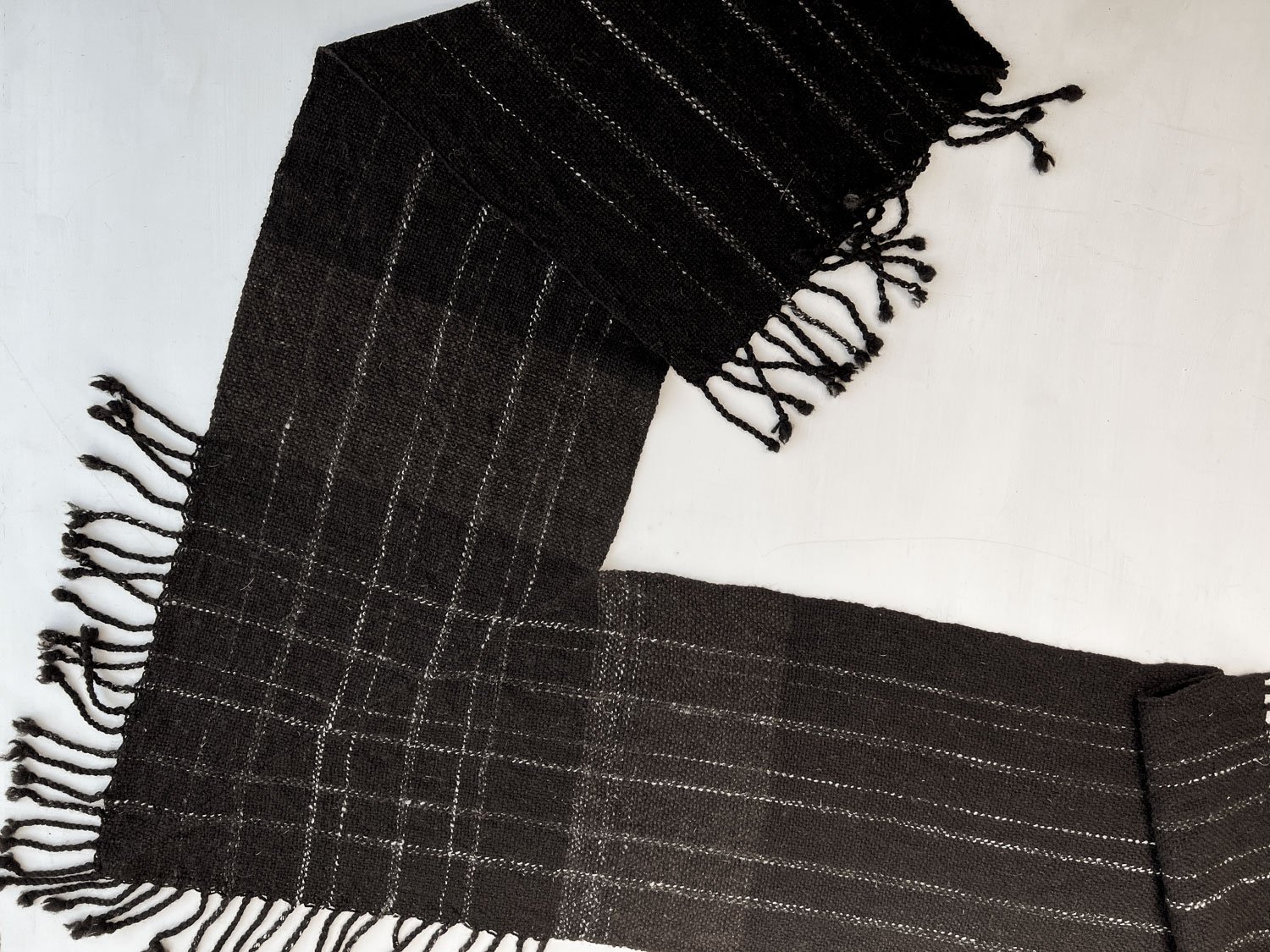
This is a handspun shawl I wove last summer using wool from Beauty, a black and white sheep. As I was weaving I knew that I’d run out of the black wool, so I spun some of Lupine’s wool to fill in. That is the gray part before the v of the shawl. (This shawl is for sale here.)
The original intent of this post was to show several ewes that I sometimes get mixed up—they are two horn lilac ewes and I think they all look similar.

This ewe is Meridian Foxy.

Meridian Vixen.

Meridian Lavender. Vixen’s and Lavender’s ear tags (ID tags in the left ear) are 6046 and 7046 so that is another way to get them mixed up.

Meridian Belle.
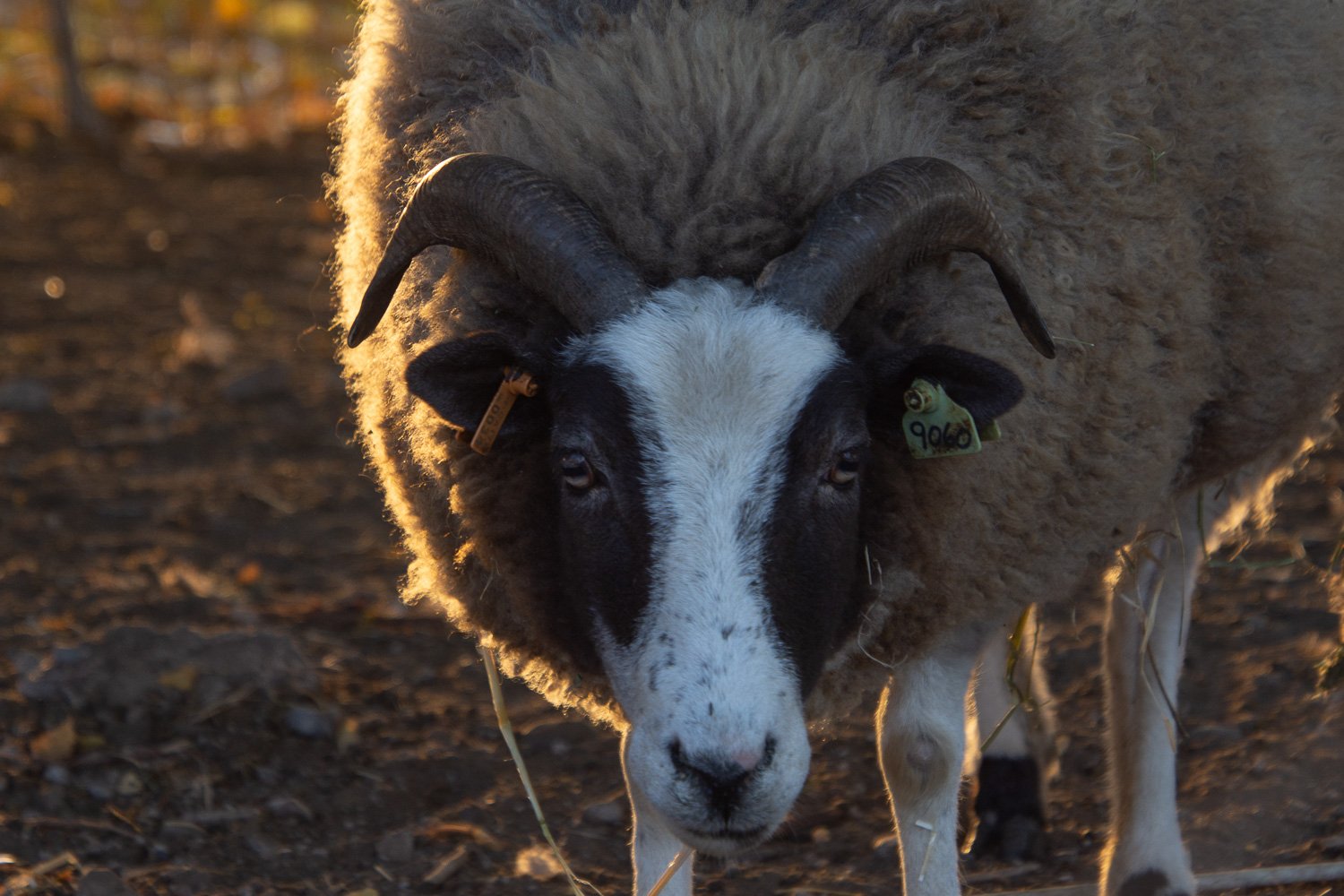
Meridian Bessie. Belle’s and Bessie’s numbers are 9006 and 9060, another reason to lose track.

The other ewes were all bred and born here. This is Patchwork Amara from Georgia.
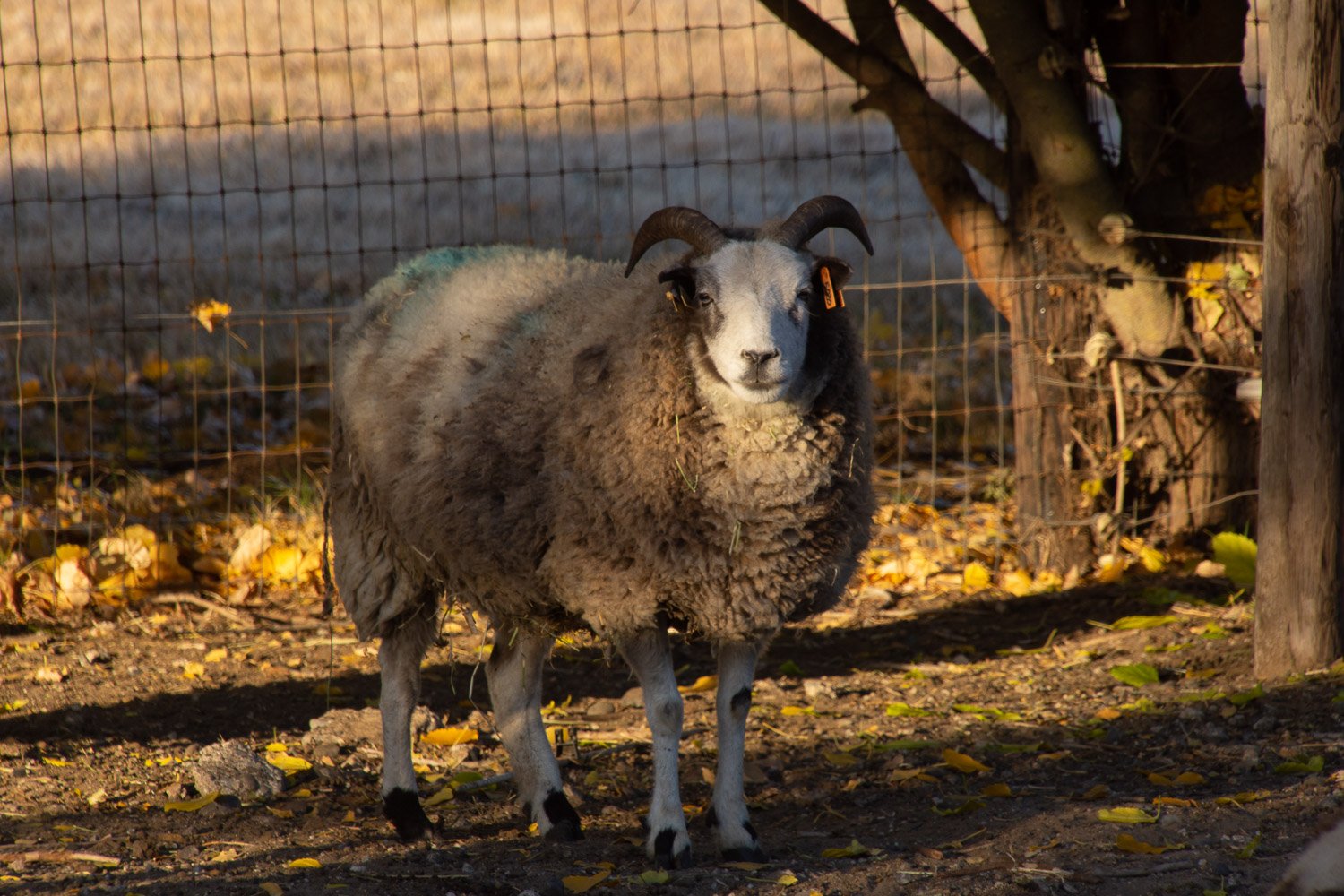
These are full body photos of the ewes above. This one is Foxy.

Vixen.

Lavender.

Belle.

Bessie.
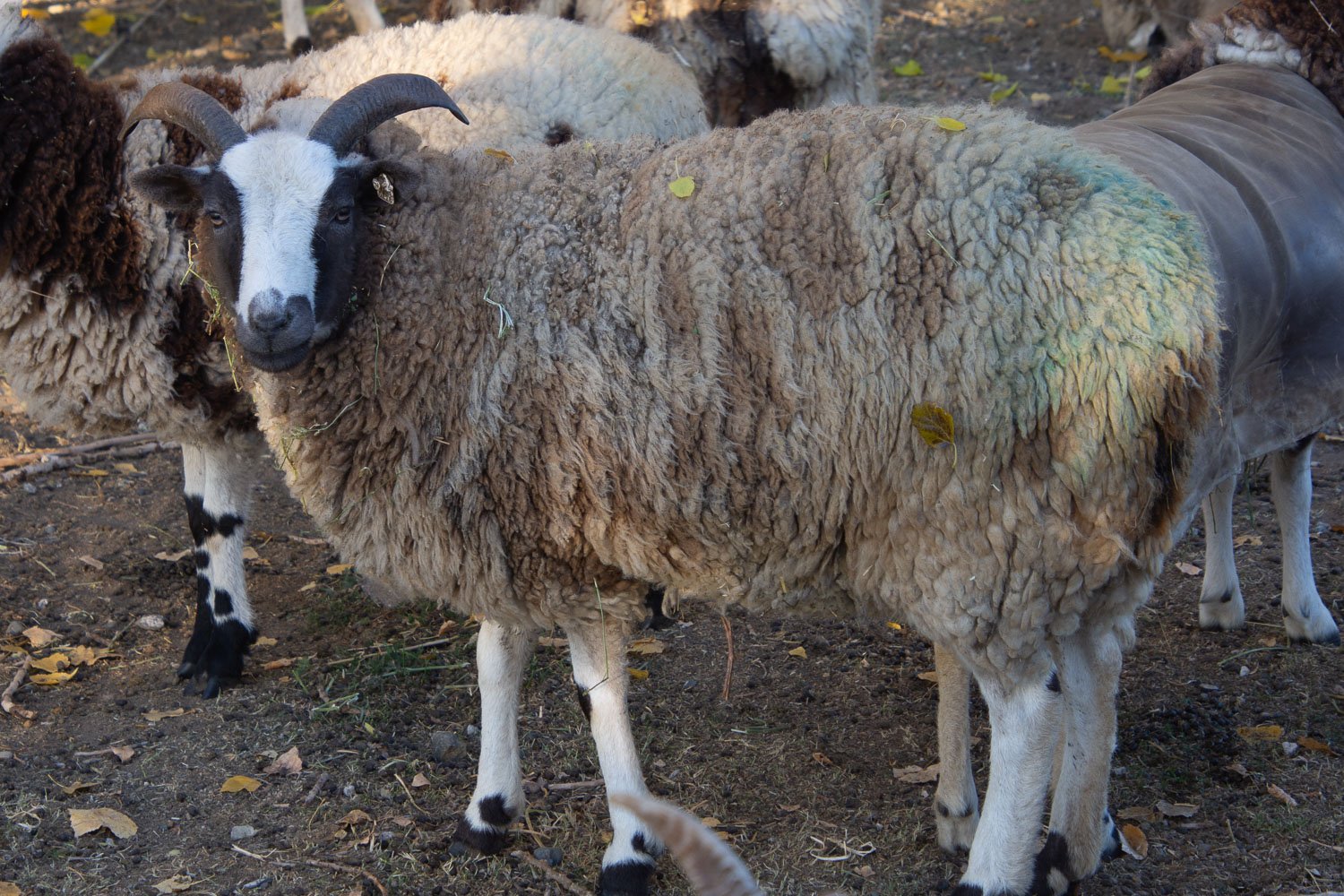
Amara.
Can you tell why I get these mixed up?

I won’t mix up these sheep, but they point out more of the variety of lilac coloring. From left to right this is Axis, Thorn, and Bravo. Axis is a yearling and the other two are March 2022 lambs. Thorn is a black and white ram, although his wool looks very dark brown in this photo—remember, that is because the tips are sunbleached. Axis and Bravo are both lilac rams but there is a big difference in the look of the wool.

Axis has the gray wool typical of my lilac Jacob ewes. Bravo’s wool is a bit browner. This photo makes him look a light brown, but that is those sunbleached tips again. Wait for shearing day for some interesting photos of the fleeces.
Lambs are still coming. This is more lambing photos and story of one lamb in need of physical therapy.
Read MoreThis was a busy day of lambing—seven ewes lambed with 12 lambs.
Read MoreI take photos thinking of sharing on the blog and then I never have time. Here is an accumulation of some from the last couple of weeks.

Patchwork Amara and Patchwork Bettylou, the two lambs that came from Georgia last summer.

Daffodils are here. I have a friend who has told me she doesn’t like daffodils because they are trying to be too cheery. (You know who you are.) I don’t agree with that, but I must say that every time I see a daffodil I think of that friend.

What time of year is this?

It is a little worrisome to see roses blooming already.

One of the chickens decided to use the bin where I throw baling twine to make a nest.

Another is using an open bale of straw.

Making compost. Dan turns this pile every so often. You can see the steam rising. The pile is warm inside. Soon we’ll need more moisture to keep it going.

Meridian Jasmine.

One of the things that has been keeping me busy is skirting fleeces and photographing them for the website. I have several listed but they aren’t live on the site yet. They will be soon. This is a coated fleece—look how long and clean it is!
It feels like the night before Christmas! …All through the barn the sheep are waiting…The barn is organized. The tools are hung (where is that strike-out thing when you need it—I wanted to say stockings but cross it out) . The rams have been moved to the barn. The water is turned off (empty stomachs are better for shearing). ETC.

Dan did this job earlier in the week. The gate we used to have here didn’t fit the space and I had a panel wired up to stick out into the doorway a couple of feet. The reason is that when the gate swings open (towards me when taking this photo) it would stick out into the south doorway to go in and out of the barn. That is not very pracrtical. So Dan designed and made a folding gate.

Here is is in use. Clever, isn’t it?

Yesterday we went to a friend’s place just up the road to pick up her Jacob sheep and bring them here for shearing. There are 16 or 17 ewes and one ram. This is the ram, born in 2021.

The next few photos are some of her ewes. They weren’t crazy about getting their photos taken—or maybe it was about me being in the pen with them.

A couple of pretty ewe lambs.


It will be fun to get hands-on these sheep and see their fleeces. We sheared them last year as well and they were a lot cleaner than mine as far as the vegetable matter goes—probably because they have winter pasture and are not being fed as much hay.

Tonight I brought my rams over to the barn so that I don’t have to deal with them in the morning. This is Rambler. He’s still a yearling—coming up on 2 years old in March.

Rambler’s fleece

Silverado (Ruby Peak Tamarisk x Meridian Spice), born almost a year ago in 2021.

Meridian Axis, a lilac ram also born in 2021. (Meridian Axle x Meridian Vixen)

Hillside Gabby’s Barrett, the ram lamb I got from the Hillside Farm in Michigan last summer. He is maturing nicely.

Barrett’s fleece.
Remember what I said about the Night Before Christmas? I’d better get to bed and read for awhile to turn my mind off so I can sleep. What’s that? Do I hear little hooves on the roof? Did I shut all the gates in the barn?
Photos of sheep and the story of why this group is named after nuts.
Read MoreI had a couple of comments after the last post “A Ram Retrospective”. One person asked about Rotor. I couldn’t include all the rams I’ve ever had, but how could I forget Rotor?

Rotor had the unimaginable triumph of winning Supreme Champion Ram at the 2016 CA State Fair. That means the judge placed him over all the other breed champions. I don’t know what the talk in the barn was after that. Usually it’s one of the “regular” breeds that win.

This photo isn’t very sharp, but you get the feel of what the Supreme Champion competition looks like. Rotor and I are third from the left dwarfed by those huge rams, all perfectly fitted for the show. Jacob sheep are shown in a much more natural state, at least by those of us showing on the West Coast.

While I was looking for those last photos I came across this one. In the last blog there was a photo of Axle at almost three years and his horns had curled very close to his face. Axle was Breed Champion (Primitive Breeds) at the State Fair when he was a yearling.

At four months old his horns looked very promising. Many lambs are born with nice markings and good fleece, but a ram has to have horns that won’t impact his future well-being. With a two horn ram that means they need a nice wide spread.

Axle at 9 months.

Axle, almost three years. That horn on his right is getting pretty close to the jaw.
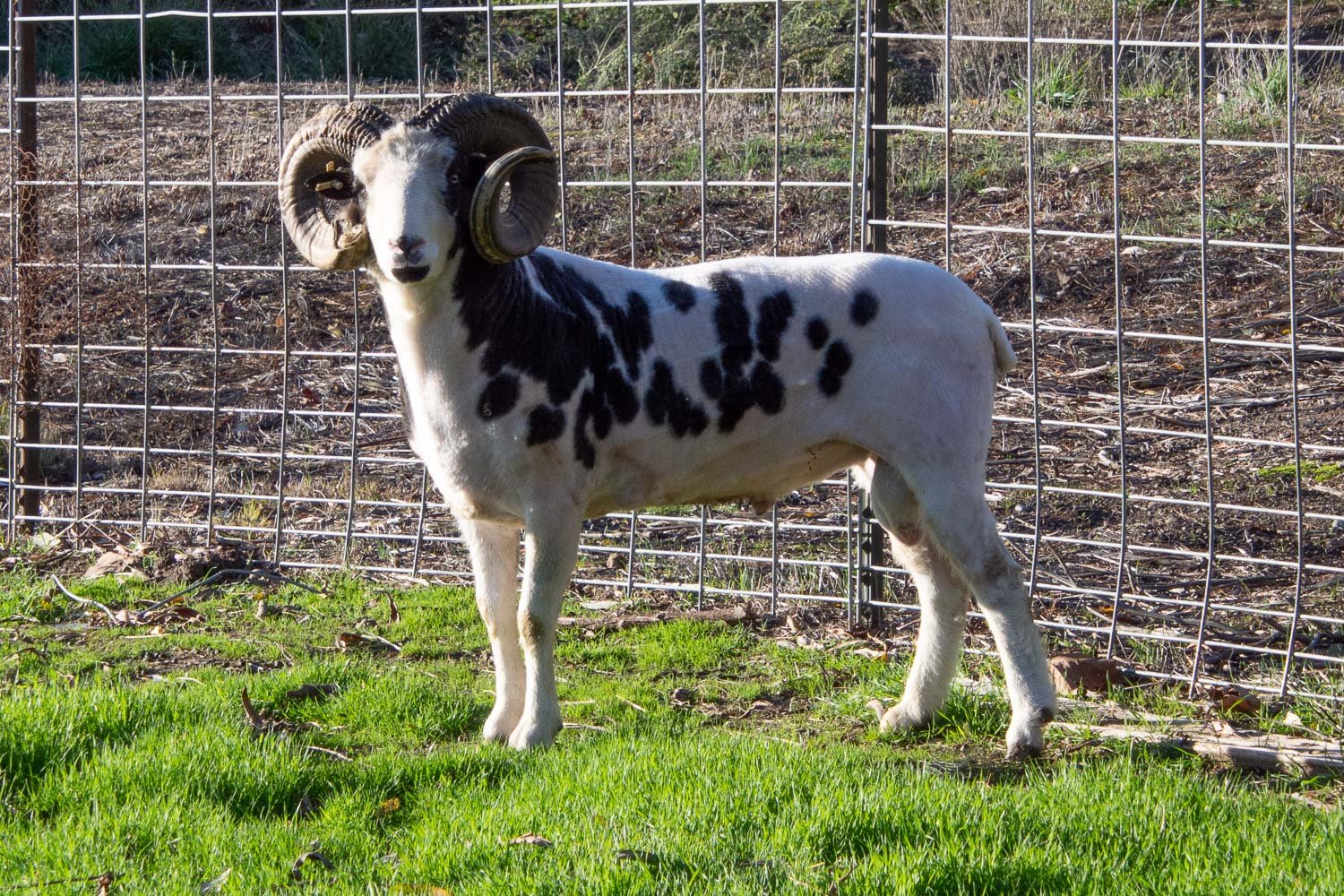
This photo was taken a few months after the last one. Axle has broken that right horn—I’m not sure how. Shortly after this he was sold to someone who was moving with her flock to Montana. Hopefully he is still there siring beautiful lambs.

I will remember Axle for the fun time we had at the 2019 Black Sheep Gathering Spinners Lead. I can’t imagine another of my rams standing so patiently on a halter with lots of other sheep around for the hour or so that we were lined up and waiting our turn. By the way, the scarves that he and I are wearing are his wool spun and woven that spring.
Axle has 7 or 8 offspring in the flock now.

Meridian Pecan…

and her twin Meridian Sandie.

Meridian Hazel, daughter of Axle and Jade, the most friendly sheep here. Hazel is #2 in line for scratches (and treats).
I’m organizing some of my photos and have a lot I took thinking of blog posts but I never wrote those posts. Here we go with some of the more recent Random Farm Photos.

Quinci is one of the 2021 ewe lambs born in March. Look at that fleece! We will shear in about 2-1/2 months and we’ll have some gorgeous fleeces.

This is the fleece of another ewe lamb who has mostly dark fiber.

Coating the sheep keeps the fleeces beautifully clean—free of VM (vegetable matter, which is usually hay in our system). But the problem with coats is that there is a lot of maintenance, especially in a horned breed. Coats need changing at least 3 or 4 times a year as the fleece grows in addition to when they are too torn to stay on the sheep. This is a patch job by one of the Farm Club members. Besides I don’t really like seeing them in coats. I’d rather see their wool. I always have a few though to have those wonderful clean fleeces.

Do you remember these three? I introduced them awhile ago. I got these ewe lambs in August and they are usually found together. From back to front that’s Hillside Grace, Patchwork Amara, and Patchwork Bettylou.

Ewes heading to pasture on an overcast morning.

This one is in the category of “sheep problem”. I had just put the two tame wethers in a separate area. Why this one decided he needed to be IN the feeder I don’t know. I couldn’t get him out without calling Dan. He couldn’t go forward because his hips were stuck. I couldn’t pull him out by myself. We did get him out and I put that feeder on its side for now so he wouldn’t try that again.

Another sheep problem. I found this after I put the rams back together. This is Barrett, the smallest ram. I had forgotten to take his marking harness off but that wasn’t the problem here. He got his head through the welded wire panel and couldn’t pull it out. It took two of us to manipulate his head just right while pushing on the wire to get him out.
These are examples of why it is a little worrisome when we leave and I am asking other people to take care of things here. In fact, I think it was when we were in Texas this summer that one of my friends had to deal with the sheep-in-the-feeder problem—same feeder, different sheep. She had to call on another friend who came over to help get the sheep out.

This is Meridian Silverado, Meridian Dylan, and Hillside Barrett. Barrett is the lamb with his head in the fence in the last photo. Dylan is now living in Nevada, and Silverado is here.

Axis is the other ram lamb who is staying here.
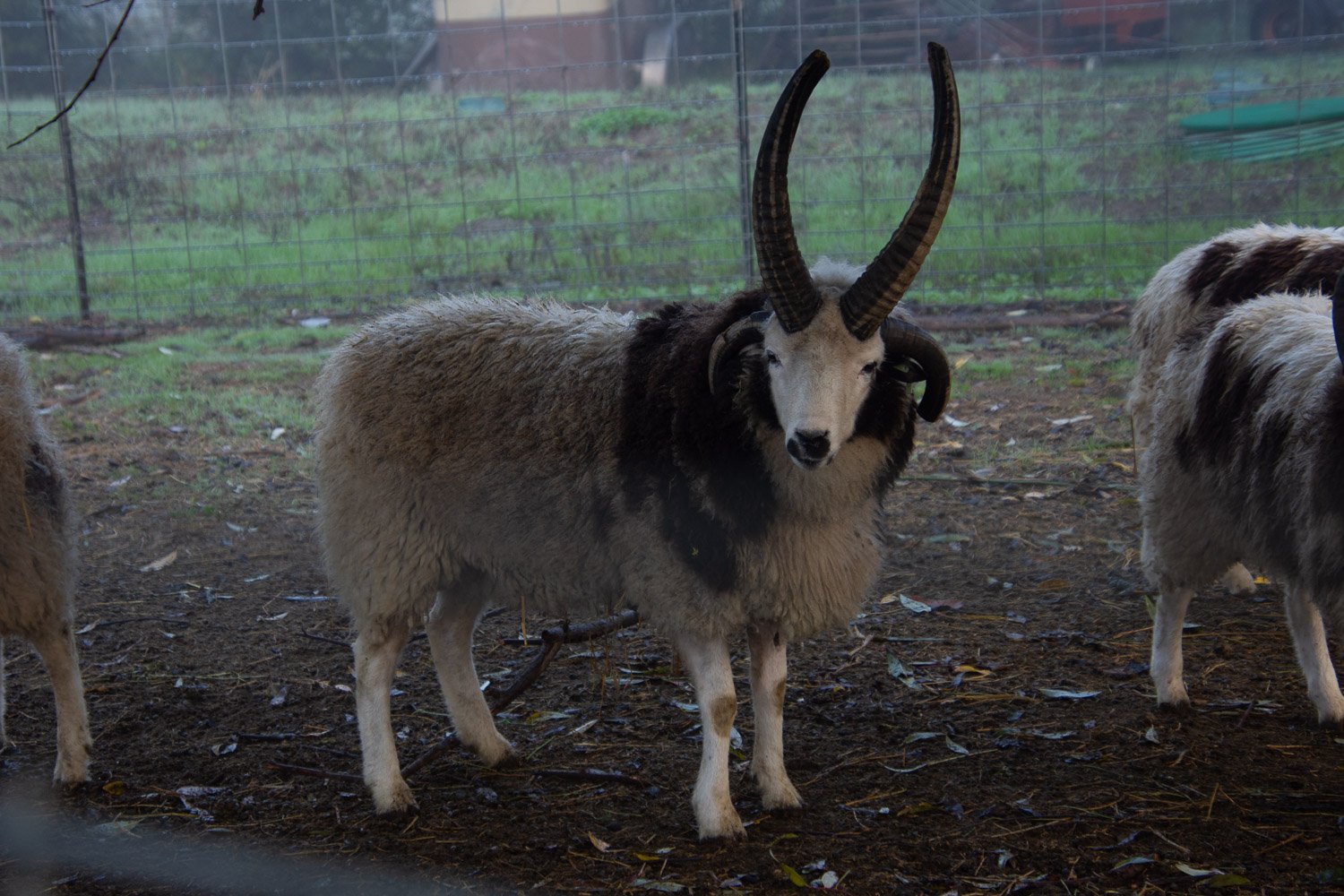
Rambler is the yearling ram.

One last photo. This is Sunny lying on top of me.
When I wrote last night’s blog post I realized that I had too many photos (as usual) and it really should be told in two parts. The plan had been for all of us to go to the Sacramento Ironman and support Chris in this event. It was not to be. The record breaking rainfall caused them to cancel the event at the very last minute. That is a whole other story and this post is about the rain at the farm on Sunday.

I took this photo around noon and by that time we’d had over 3” of rain. When the storm was over I had measured a total of 6.8” here. That’s a lot for 24 hours especially considering that our average annual rainfall is about 24”. This photo wouldn’t be unusual during times of heavy storms over multiple days in a “normal” rainfall year, but we haven’t had a normal year in a long time.

I had moved breeding groups around the day before in anticipation of this. This is a group that would have been in standing water with no shelter. They moved to the donkey pen (no donkey anymore) which had at least a few dry spots.

The barn was flooding from the south and I realized that it had been a long time since I’d had to dig ditches.

This ditch brought water from the south and east sides of the barn into the main irrigation ditch. That ditch was so full it looked as though we were irrigating. I checked the end of the ditch where it flows off the property and dug out a few more spots to help the water flow a little faster.

This group had a dry spot at the corner of the barn because they weren’t going to try and cross Lake Meridian.

Kirby spent part of the day in town with her cousins but was ready for some sheep time when she got back. Katie had bought her new rain gear in anticipation of spending a soggy day at the Ironman. She was able to wear it here.

First we spent some time with the favorite sheep. Snacks for these two.

BettyLou is one of the new lambs who really likes her cookies, but usually from someone she knows. Kirby has enough sheep sense that she was able to entice BettyLou to take the cookie.

Do you remember the hopscotch photo from yesterday’s post? A little rain wasn’t going to stop Kirby from using her hopscotch grid.
Kirby and Katie left early Monday morning to fly back to Texas. The day was dry and sunny. The sky was blue, cleaner than we’d seen it all summer, after all the dust and smoke were washed from the sky.
We live by seasons…and this one is breeding season.

On Sunday Farm Club members came to help. We started by sorting ewes. We also replaced old smaller ear tags with some that are a little larger and more legible. We colored coded the 2018 and 2019 ear tags. I had already tagged the 2020 ewes with blue tags. I can identify many of the sheep by their markings but I don’t remember all 60+ of them. The larger ear tags make it easier to read the tag and to find a particular sheep when you can narrow down the year by the ear tag color.

Then we put the markers in the ram harnesses.
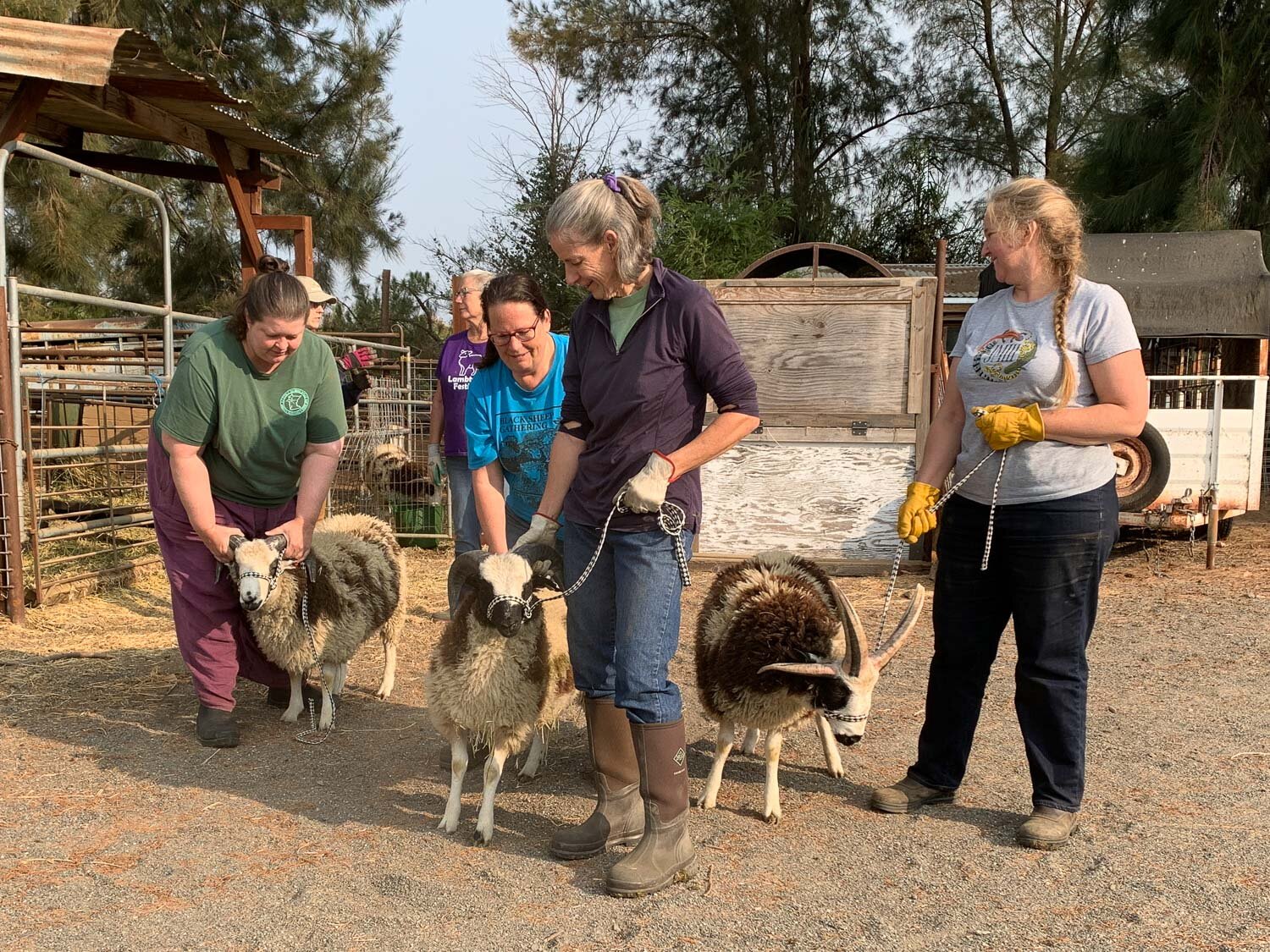
It was time to get the rams. Farm Club members went to get the ram lambs. I had worked with Axis (left) and Silverado (right) a bit…

…but Barrett is the new one and he thought dragging was the way to go rather than walking…

…or maybe giving up was best.

We had planned a break at 10:00 to watch the Lambtown Sheep-to-Shawl judging. We missed the first part so didn’t hear what most of what they said about ours—we can watch the recording when it’s posted.

The judging presentation was good, but unfortunately our shawl was among the four that were disqualified based on size. We were short of the desired 72” by only about 2”. I guess we were in good company. Back to work.

The lamb, Axis, got down to business right away.

The youngest one, Barrett, was interested but the ewes wanted nothing to do with him. In cases you’re wondering, it’s not that he’s too little, it’s just that they aren’t in heat right now.

Dan and I caught the big rams.

Tamarisk’s face has been looking a little rough, but he seems OK other than something under his jaw. (Thanks for the photos Susan.)

I caught him about a week ago to check out his swollen face. He has something going on with his jaw but I think that whatever it is has healed—it’s hard like bone, not soft like an abscess. He still eats and is in good flesh.

If there is something with his jaw it’s not on his mind right now.

I had to chase this group out to the pasture because they got distracted by each other and were just hanging around the lane.
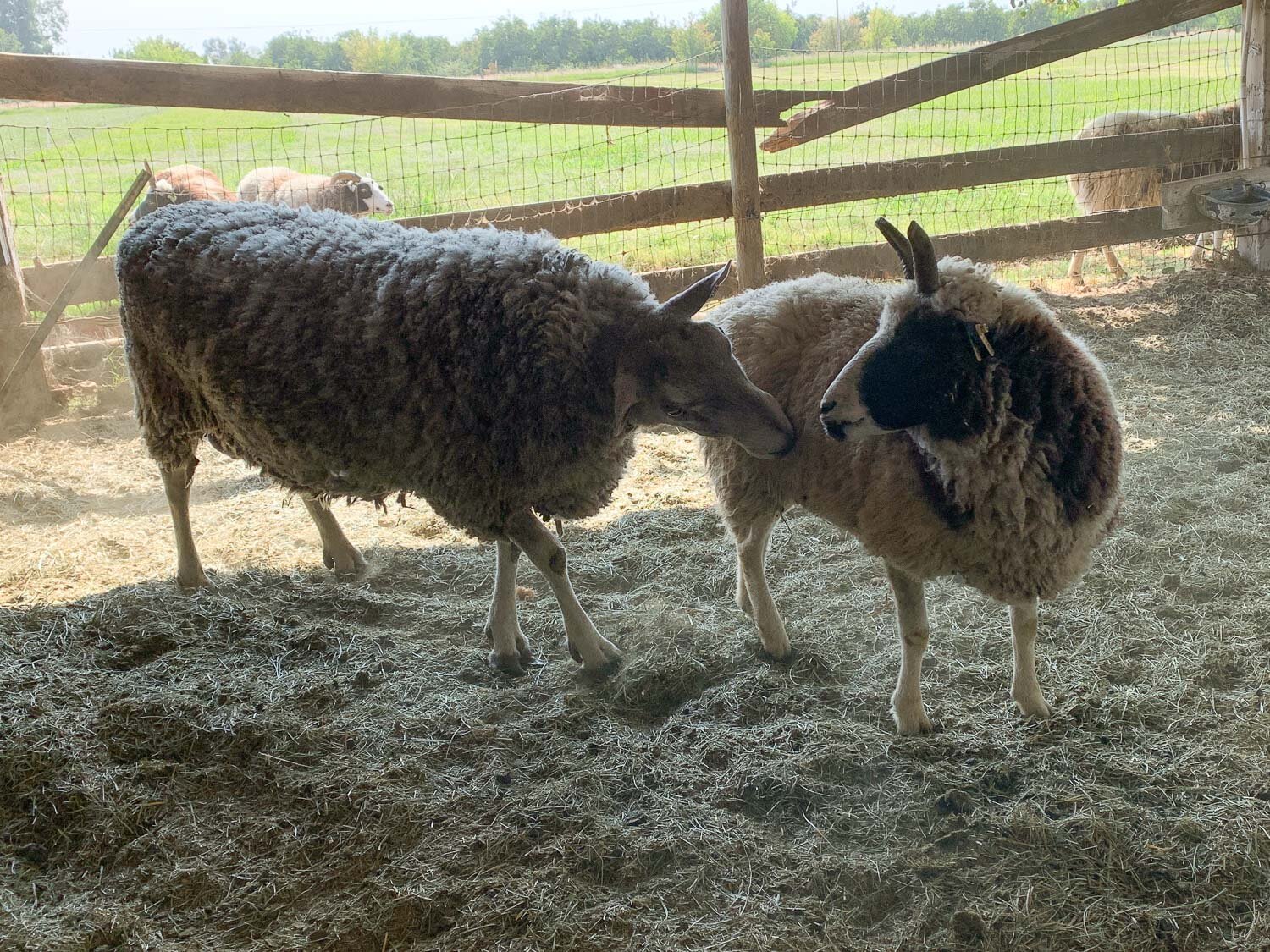
Peyton was happy to have some female company.

Ram lamb, Silverado, seemed more interested in the smells in the ram pen where the older rams had been.

Rambler’s group also has a pasture that is separate from Tamarisk but they can also go into the corral near the barn.

Everybody’s favorite ewe, Jade, was the first to be marked.

Rambler, Tamarisk, and Peyton all wore themselves out on Sunday afternoon. Among them 10 ewes were already marked.


I have two extra ram lambs, Dylan with 4 horns and Orion with 2 horns. They are both for sale as registered breeding rams.

This is the third day the rams have been with the ewes. Tamarisk has bred 10 of his group of 21 so far.

Peyton has bred 4 of his 5 ewes.

Axis is a lilac ram with some of the lilac ewes and ewes that carry lilac in their pedigrees.


He has marked Zora, left, and Foxy, right and 2 other ewes so far.

I’m still waiting for Barrett (in this photo) and Silverado to mark someone. Maybe tonight.
A friend who raises Jacob sheep in Pennsylvania emailed me that a ewe that came from here won Champion Jacob ewe at the Garden State Sheep & Fiber Festival in New Jersey. Since all the shows I might have gone to out here were cancelled I’ll live vicariously through others’ fun events, and this news prompted me to write this blog post.

This is Royal Unzicker of Ivy Brook Meadows with Meridian Saffron. At the shows I attend in California and Oregon sheep are shown as lambs and yearlings, but Royal was able to enter Saffron in an Aged Ewe class at this show. (Thanks to Brittany Smith for this photo and the one of the ram.)
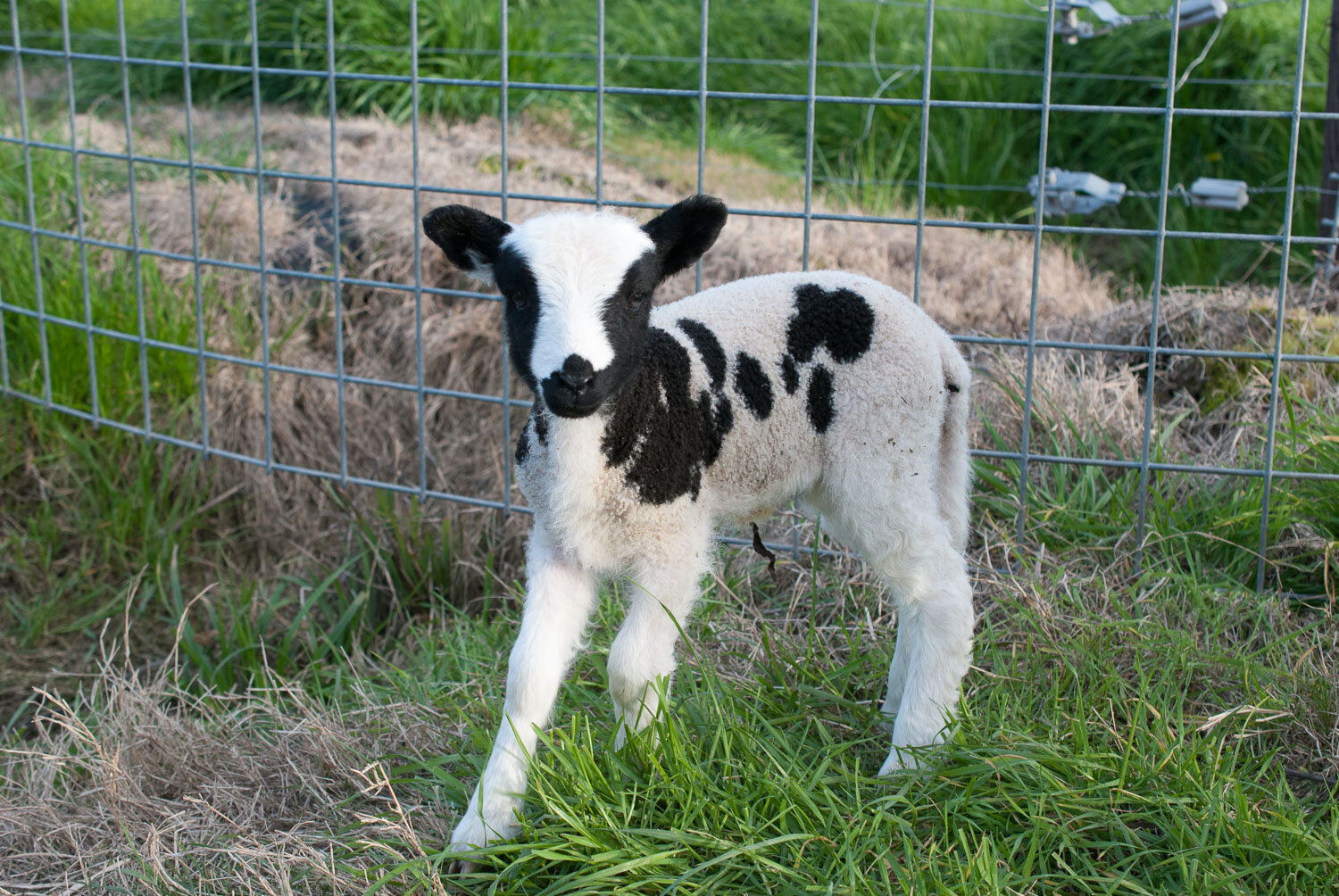
Here is a baby picture of Saffron in 2017.
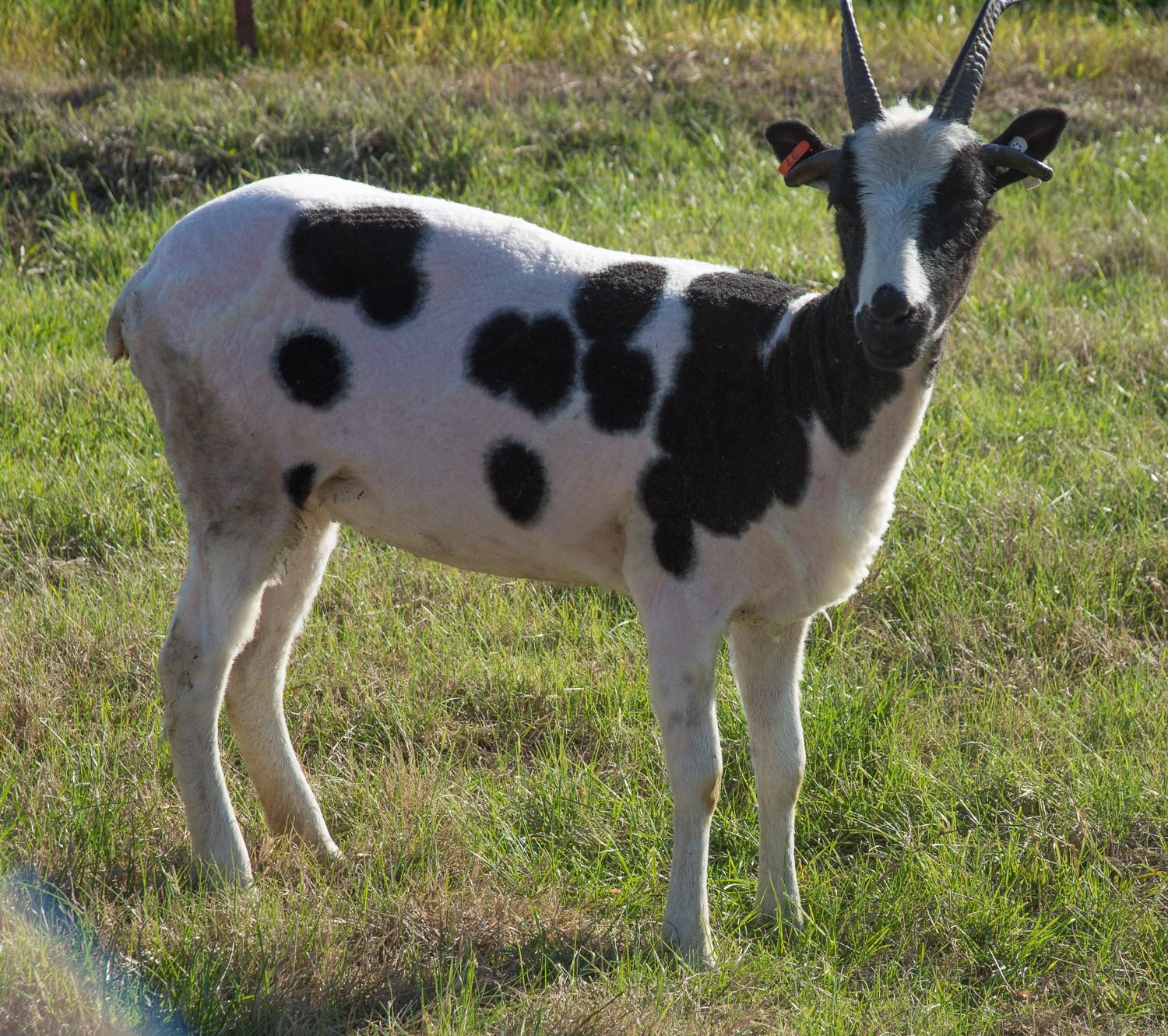
Here she is after her first shearing.

This is what her fleece looked like before shearing. Royal bought Saffron in 2018 with the plan that she and two other yearlings could make it to Maryland Sheep & Wool Festival in May by catching a ride with the sheep of another friend who shows back there every year.

Saffron’s sire is bide a wee Buster of the Bide a Wee farm in Oregon. This is a photo from his first season of breeding here.

Buster is on the left with Clark, one of his sons, on the right. I find it interesting to compare the lamb and adult photos. Buster has sired a lot of sheep, some of whom are still here.

The combination of Sonata (the ewe in this photo) and Buster produced another nice lamb, Soprano, in 2018.

This is Soprano as a yearling at Black Sheep Gathering in 2019.

Royal did very well at the show where he showed the Champion Jacob ewe. He also showed the Champion Jacob ram, the Reserve Champions, and Best Flock. This is Patchwork Cooper. Patchwork Farm is where two of my new lambs came from and I think Cooper is somehow related but now I don’t remember how. I sure love those horns.
I think that I should add here, that it’s not all about the showing. All of us have plenty of nice sheep that have never won awards and we all point out that it is just one person’s opinion on one day so it’s not really that important. But, hey, the shows are fun and why not brag when you have the chance? I hope that we’ll be able to do a little bragging next year, but the first step will be that the shows won’t be cancelled. The biggest news I heard about the California State Fair for 2022 is that they have a new category to enter—Cannabis. Is that enough to make sure the fair goes ahead as planned?
At Meridian Jacobs farm we raise Jacob sheep and sell locally grown wool fiber, yarn, and handwoven goods. We teach fiber classes and sell Ashford, Clemes & Clemes, and Schacht spinning and weaving equipment. We encourage farm visits with field trips and our unique Farm Club.
Search blog posts since 2019. If the search says it can’t find a post try putting in your search word a second time. I don’t know why but the second time it seems to work.
Search the entire website, including older blog posts.